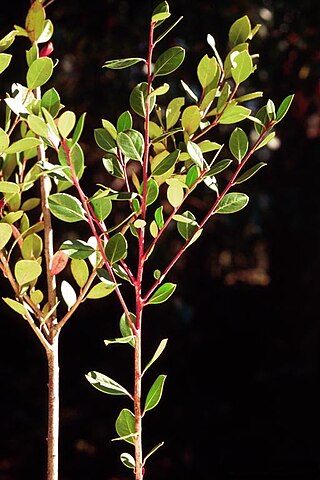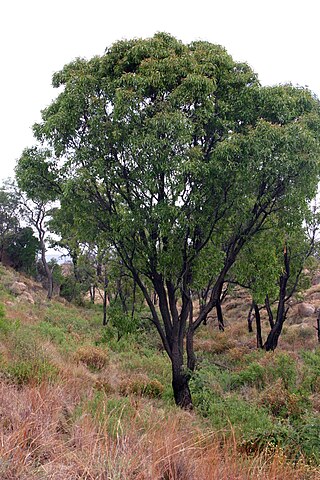
The leatherback sea turtle, sometimes called the lute turtle, leathery turtle or simply the luth, is the largest of all living turtles and the heaviest non-crocodilian reptile, reaching lengths of up to 1.8 metres and weights of 500 kilograms (1,100 lb). It is the only living species in the genus Dermochelys and family Dermochelyidae. It can easily be differentiated from other modern sea turtles by its lack of a bony shell; instead, its carapace is covered by oily flesh and flexible, leather-like skin, for which it is named.

The moapa dace is a rare cyprinid fish of southern Nevada, United States, found only in the upper parts of the Muddy River, and in the warm springs that give rise to the river. It is the only species of the monotypic genus Moapa.

The dapple-throat is a species of bird in the small African family Modulatricidae. Other common names include dappled mountain robin and dappled mountain greenbul. It is native to Mozambique and Tanzania. This is the only species in the monotypic genus Arcanator.

Faurea macnaughtonii is a species of tree in the family Proteaceae. It is found in South Africa and Eswatini, and was named in honour of Colin B. MacNaughton, Conservator of Forests at Knysna during the 1890s.

Faurea is a genus containing 16 species of flowering plants in the protea family which occur in the summer rainfall area of southern Africa, extending to tropical Africa and Madagascar. The name honours South African soldier and botanist William Caldwell Faure (1822-1844) who was killed on active service in India.
Horsfieldia coriacea is a species of plant in the family Myristicaceae. It is a tree endemic to Sulawesi in Indonesia.
Kibara coriacea is a plant in the family Monimiaceae. The specific epithet coriacea is from the Latin meaning "leathery", referring to the leaves.
Magnolia coriacea is a species of flowering plant in the family Magnoliaceae. It is native to China. There are no more than about 500 individuals remaining of this endangered species.
Vatica coriacea is a tree in the family Dipterocarpaceae, native to Borneo. The specific epithet coriacea means "leathery", referring to the leaves.
Wikstroemia coriacea is a species of plant in the Thymelaeaceae family. It is native to French Polynesia and the Cook Islands, Tonga, and Niue.
Chamaemeles is a monotypic genus of flowering plants in the family Rosaceae. Its only species, Chamaemeles coriacea, is endemic to Madeira.
Posidonia coriacea is a species of seagrass that occurs in the southern waters of Australia.

Ilex coriacea, sometimes known as large gallberry or sweet gallberry, is a shrub in the holly family native to coastal areas in the United States from Virginia to Texas. It exists primarily as an understory plant in pine forests, and is sometimes stimulated by regular controlled burnings.

Faurea saligna is a graceful, semi-deciduous tree of the family Proteaceae growing to about 10 metres, or up to 20 metres under forest conditions. Found from tropical Africa south to the Transvaal, Swaziland and Natal, often in large communities on sandy soil and along stream beds.
Diospyros coriacea is a tree in the family Ebenaceae. The specific epithet coriacea means "leathery", referring to the leaves. The species is native to Peninsular Malaysia, Singapore and Borneo.

Faurea galpinii is a small tree that grows to 10 m (20 ft.) tall, but its trunks will vary depending on growing conditions. The leaves of F. galpinii are alternately lanceolate with wavy margins. When growing in the forest, the bark appears grey with smooth, concentric rings, although it can appear rough and dark under exposed conditions, and the variety Faurea gal pinii varies in size from 1 m to 2 m.

Faurea rochetiana, also known as the broad-leaved beechwood, is a tree found in much of Africa from Sudan south to Limpopo, Mpumalanga and northern KwaZulu-Natal. The tree is small and leafy. It has wider leaves, larger flowers and flower veins and also denser hairy twigs than the bushveld beechwood. The tree's national number is 76.
Faurea recondita, also known as the Kamdeboo beechwood, is a tree that forms part of the genus Faurea. It occurs in the Kamdeboo Mountains. The species was only identified in 2013 after it was discovered in 2008. The tree grows on average two metres high. It has many similarities with Faurea coriacea found in Madagascar.
Faurea racemosa is a tree that forms part of the Faurea genus and is native to Malawi and Mozambique.
Faurea forficuliflora is a tree that forms part of the Faurea genus and is endemic to Madagascar.









